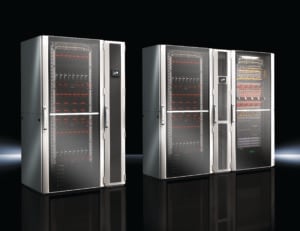
Of all the concerns for an edge data center, cooling capacity consistently rates as a primary focus. A checklist of requirements includes:
- Selecting a climate control system that is well matched to the heat output of the edge data center,
- Providing adequate air flow to each server rack,
- Assured operational reliability of the cooling and redundancy,
- Maintaining constant acceptable levels of temperature and humidity,
- Having options for scalability both at the rack level and the edge data center as a whole.
Considering the Variables in Edge Computing
Heat dissipation and the inherent heat problems in edge computing require modular climate control systems. Variables like temperature, humidity, the velocity and pressure of air flows, and the heat losses of the installed components are considered in development. An energy-efficient and advanced climate control and cooling concept for edge computing takes into account these variables.
Consider these fundamental criteria and variants in the design phase:
What type of Liquid Cooling Package (LCP) cooling system should be installed? Whether a water or refrigerant based system should be used can depend both on environment and the availability of a water supply.
Will the amount of racks and enclosures require hot and cold aisles? Cold aisle containment usually requires a raised floor. If a space is being retrofitted to accommodate enclosure racks, this design consideration may influence the decision.
What average temperatures should be maintained in the racks? It is still widely accepted that racks should be maintained at a cooler temperature, no more than 68° to 72°F. Set point temperature required depends in part on the heat output calculations for the rack enclosure. With densely populated edge centers, additional cooling power may be needed to offset the higher heat loads.
Is the volumetric flow rate of cooled air required? Calculating the air flow requirement for each center depends on the rack requirements to design an efficient air flow strategy. Rack, inline or a combination may be the correct solution.
What are the ambient conditions? Temperature extremes in either direction will affect the energy required to maintain an acceptable environment for the racks. The degree to which ambient temperature may assist/hinder cooling may depend on the efficiency of the system and the density of the racks.
Which way will the airflow be directed? Directing the most cool air flow to the front of the racks is desirable, but how will the heated air be discharged? Standard air flow management in a small data center provides different challenges.
Do load fluctuations exist and what impact do these have on the cooling response times? If the operation of the data center will see variations in energy use, a selected cooling system should be adaptable to the variations in power needs.
Should the system be scalable for future expansion? Having a system which can adapt to baying or can support additional rack cooling over the existing needs will eliminate costs if additional computing power is needed.
The Cooling Decision
Cooling the edge computing microcenter can be approached most effectively via a liquid cooling system, either inline based, rack based, or a combination of both. There are basically two heat transfer media with which systems can be operated: water and refrigerant. Water offers exceptional cooling properties, well suited to the high heat output of an edge system. Refrigerant based cooling is well suited to small or medium edge enclosures, especially when a water supply is not readily available. Refrigerant cooling often operates on a smaller footprint, efficient in microcenters. In both cases, energy efficiency is a consideration.
The energy-efficient IT climate control system takes account of:
- Dimensioning of the cooling systems to match the actual power requirements
- Separation of cooling for server racks and room air-conditioning by partitioning of aisles
- Use of energy-efficient components, e.g. electronically commutated (EC) fans including power regulation of the cooling compressors
- Keeping the cooling water and room temperatures as high as possible
- Controlling all subsystems and continuous adaptation to the actual cooling power requirements
Moving toward edge computing makes sense in many industries. With the rapidly increasing volume of data available from IoT, to the necessity of reduced latency in analysis and the finite amount of bandwidth available at legacy data centers, edge computing solves these concerns. Understanding what the edge computing environment will require is not dissimilar to the checklist for any data center, calculating heat output, providing adequate cooling, assured reliability and scalability. Proper cooling allows the environment for each component to function at maximum capability.
Learn more in our Edge Computing Guide.
